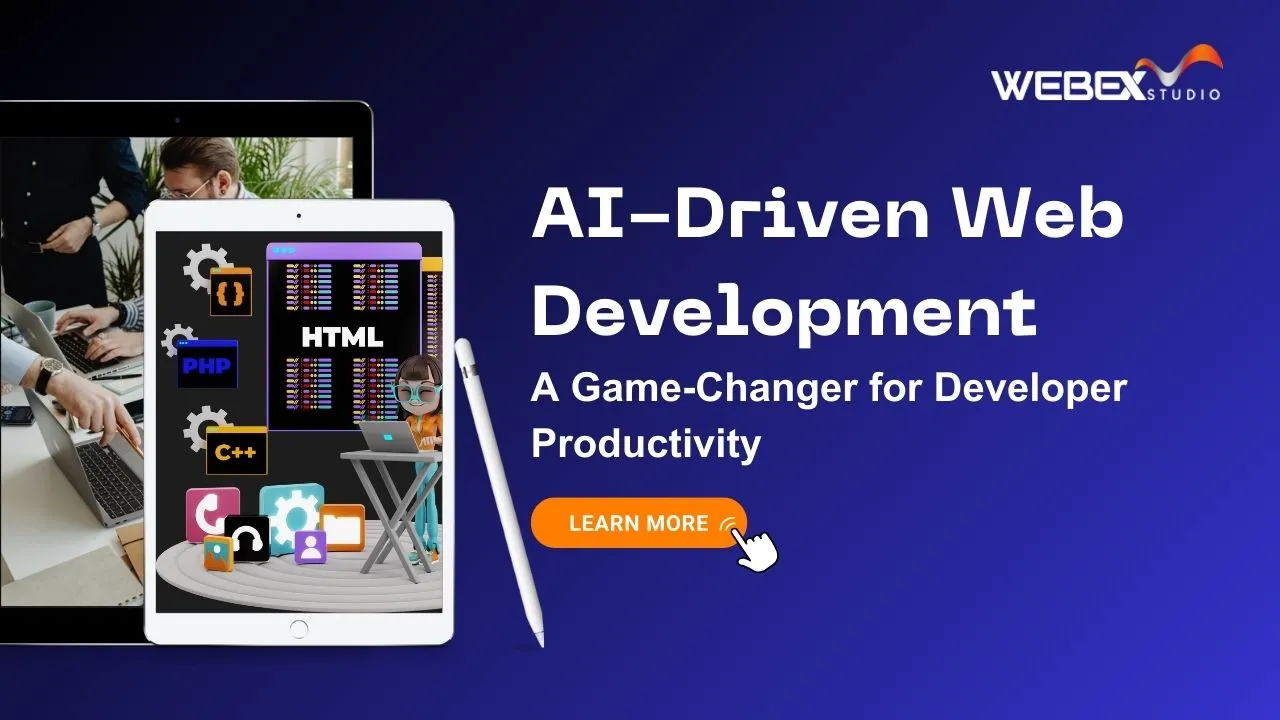WordPress has been the buzzing word all over 2023 as the world’s most popular content management system. Since it’s been ever-evolving and stands as a dynamic maestro orchestrating the symphony of online creativity, we expect some significant trends in 2024.
Let’s explore the Top 15 WordPress Development Trends that shape the landscape of digital craftsmanship. From immersive user experiences to the magic of headless architectures, each trend paints a pixelated stroke in the canvas of the future.
Key Latest WordPress Statistics:
1. WordPress commands a hefty 36.28% share among the top 1 million websites.
2. W3Techs data reveals that WordPress was the platform of choice for 45.8% of all websites worldwide in 2023, witnessing an uptick from 43.2% in 2022.
3. Starting at a modest 13.1% in 2011, WordPress has seen a consistent 12% annual growth, culminating in a 43.2% usage rate by 2022.
4. The official WordPress plugin directory boasts an extensive collection of nearly 60,000 free plugins.
5. Notably, Yoast SEO takes the lead with the highest number of active installations and five-star ratings in the WordPress plugin directory.
Top 15 WordPress Development Trends
Embark on a journey through the ever-evolving world of WordPress development.
-
☑ WordPress 6.1
WordPress 6.1 unveils cutting-edge features, enhancing user experience and site management. Improved block editor capabilities streamline content creation, offering flexibility and efficiency.
Performance Boost:
With optimized code and enhanced caching mechanisms, the update promises faster loading times and improved overall performance. Users can expect a seamless and responsive website, contributing to a better visitor experience.
Security Enhancements:
WordPress 6.1 prioritizes security, introducing robust measures to safeguard websites. Enhanced firewall and malware detection tools fortify defenses against potential threats, ensuring a safer online environment.
User Interface Refinements:
The user interface undergoes a makeover, focusing on accessibility and simplicity. Streamlined navigation and updated design elements contribute to a more intuitive and user-friendly dashboard.
Compatibility:
WordPress 6.1 ensures compatibility with the latest technologies, plugins, and themes, fostering a dynamic ecosystem for developers and users alike.
-
☑ WordPress VIP
Overview:
WordPress VIP is a premium enterprise solution designed to meet the complex demands of high-profile websites. Tailored for scalability and performance, it’s the go-to choice for large-scale businesses and top-tier publishers.
Unrivaled Performance:
With optimized hosting and advanced caching, WordPress VIP ensures unparalleled speed and reliability. Its architecture is finely tuned to handle massive traffic spikes, providing a seamless user experience even under intense demand.
Security Excellence:
WordPress VIP prioritizes security, employing robust measures and continuous monitoring to safeguard against cyber threats. Regular audits and updates contribute to airtight protection for mission-critical content.
24/7 Support:
Clients benefit from round-the-clock support, ensuring prompt resolution of issues and expert guidance. The VIP support team’s expertise is a cornerstone for clients relying on WordPress for their mission-critical operations.
Scalability and Flexibility:
WordPress VIP offers a flexible environment, accommodating the unique needs of growing enterprises. It provides a scalable platform that evolves with the expanding requirements of dynamic businesses.
Innovation Hub:
As a WordPress VIP client, access to the latest innovations, updates, and features is prioritized. This ensures that organizations stay at the forefront of web development trends, harnessing the power of WordPress’s continuous evolution.
-
☑ Voice search integration
Seamless Interaction:
WordPress embraces the future with voice search integration, enabling users to interact with websites effortlessly through spoken commands.
Improved User Experience:
This feature enhances accessibility, providing a hands-free browsing experience. Users can now navigate content, search, and engage with websites using voice commands, making it particularly beneficial for those with mobility challenges.
Optimized Content Strategy:
Website owners must adapt their content strategy to align with voice search patterns. This includes incorporating natural language, featured snippets, and concise, informative responses to common queries.
Plugin Integration:
WordPress users can leverage dedicated plugins to effortlessly integrate voice search functionality into their websites, ensuring a smooth and user-friendly experience.
-
☑ Automatic updates
Effortless Management:
Automatic updates in WordPress simplify the tedious task of keeping websites current. Users can now ensure their site’s security and performance without manual intervention.
Security Reinforcement:
Automatic updates fortify websites against vulnerabilities by promptly patching and fixing potential security issues. This proactive approach enhances overall site safety.
Background Processes:
The automatic update system operates seamlessly in the background, minimizing disruptions to site functionality. Users can focus on content creation and business operations without constant update monitoring.
Plugin and Theme Support:
This feature extends to plugins and themes, ensuring that the entire WordPress ecosystem remains up-to-date. It contributes to a cohesive and secure digital environment.
Customization Control:
While automatic updates provide convenience, users retain control over their preferences. Options to enable or disable specific updates allow for a tailored approach to site management.
-
☑ Mobile-first approach
The mobile-first approach in WordPress revolves around designing websites with a primary focus on mobile devices, ensuring optimal functionality and aesthetics on smaller screens.
Responsive Design:
Implementing responsive design principles, WordPress prioritizes fluid layouts, flexible images, and media queries to seamlessly adapt content to various screen sizes, enhancing user experience across devices.
Performance Optimization:
Mobile-first emphasizes efficient performance, reducing unnecessary elements for quicker loading times on mobile devices. This contributes to improved user satisfaction and positively impacts search engine rankings.
User-Centric Design:
Prioritizing mobile users aligns with the current digital landscape, acknowledging the prevalence of mobile browsing. WordPress themes and plugins are crafted with touch-friendly navigation and user interfaces, ensuring a smooth and intuitive experience.
SEO Benefits:
Search engines favor mobile-friendly websites, making the mobile-first approach crucial for SEO. WordPress’s commitment to mobile optimization enhances visibility and rankings in search engine results.
-
☑ Minimalist theme
Clean Design:
A Minimalist Theme in WordPress prioritizes simplicity, featuring clean and uncluttered designs. Stripping away unnecessary elements, it fosters an elegant and visually appealing user interface.
Focus on Content:
These themes emphasize content over flashy design, creating a distraction-free environment for users. The minimalist approach enhances readability and ensures that the audience’s focus remains on the essential content.
Lightweight and Fast:
Minimalist themes are typically lightweight, contributing to faster loading times. This not only improves user experience but also positively impacts SEO rankings.
Customization Options:
Despite their simplicity, Minimalist Themes offer customization options, allowing users to tailor the aesthetics to suit their brand or personal style. This flexibility ensures a unique and personalized website.
Mobile Responsiveness:
With a focus on simplicity, Minimalist Themes often come with built-in mobile responsiveness. This ensures a seamless and consistent user experience across various devices.
-
☑ Illustration
Integration:
WordPress seamlessly integrates illustration into its content creation framework, allowing users to complement textual information with visually engaging graphics.
Versatility:
From custom graphics to embedded images, illustrations in WordPress offer versatility in storytelling, making content more captivating and understandable.
Enhanced User Engagement:
Illustrations break up textual monotony, capturing the audience’s attention and fostering a more engaging user experience. They convey complex ideas succinctly, catering to diverse learning preferences.
Plugins and Themes:
WordPress boasts a plethora of plugins and themes catering specifically to illustration needs. These tools empower users to effortlessly incorporate and customize illustrations within their websites, aligning with varied aesthetics.
SEO Benefits:
Well-optimized illustrations contribute to improved SEO. Alt tags and descriptions enhance accessibility while boosting search engine visibility, driving organic traffic.
-
☑ Drag and drop website builder
User-Friendly Interface:
The drag-and-drop website builder in WordPress simplifies the design process, offering an intuitive interface that requires no coding expertise. Users can effortlessly create visually appealing layouts.
Instant Customization:
With a diverse range of pre-built elements, the builder allows for instant customization. Users can drag elements like text boxes, images, and widgets onto their pages, achieving the desired look without technical hurdles.
Responsive Design:
Ensuring mobile-friendliness, the builder facilitates the creation of responsive designs. Elements automatically adapt to different screen sizes, enhancing the user experience across devices.
Efficiency and Speed:
By eliminating the need for manual coding, the drag-and-drop builder significantly speeds up the website development process. It empowers users to prototype and refine designs with remarkable efficiency.
Plugin Compatibility:
Integrated seamlessly with WordPress plugins, the drag-and-drop builder enhances functionality. Users can easily incorporate additional features and functionalities into their websites without compromising the drag-and-drop simplicity.
-
☑ Dark Mode UI
Visual Comfort:
Dark Mode reduces eye strain, providing a visually comfortable alternative, especially during prolonged usage. Users can seamlessly toggle between light and dark interfaces based on preference and environmental conditions.
Enhanced Focus:
The subdued color palette helps draw attention to content, fostering a focused and immersive writing and editing environment.
Accessibility:
Dark Mode improves accessibility by catering to users with light sensitivity or visual impairments, ensuring a more inclusive experience for all WordPress users.
Customization:
WordPress users can personalize their workspace, choosing from various color schemes within the Dark Mode UI, reflecting individual tastes and preferences.
-
☑ Embedding Videos on Background
Easy Integration:
WordPress simplifies the process of embedding videos as background elements. Users can effortlessly integrate dynamic video content to captivate visitors.
Customization Options:
Tailor the video background to match the website’s aesthetic. WordPress offers customization options, allowing users to control video playback, mute options, and overlay effects.
Improved Engagement:
Video backgrounds elevate user engagement by providing visually immersive experiences. From showcasing products to telling a compelling brand story, videos create a lasting impact on site visitors.
Performance Considerations:
Optimize video files for faster loading times. WordPress emphasizes performance, ensuring that video backgrounds don’t compromise website speed.
Responsive Design:
Video backgrounds seamlessly adapt to different screen sizes, offering a consistent and visually appealing experience across devices.
-
☑ Parallax Scrolling
Enhanced User Experience:
This feature captivates visitors with a visually striking narrative as they scroll. Parallax scrolling adds a layer of interactivity, making the website more memorable and user-friendly.
Easy Integration:
WordPress simplifies the integration of parallax scrolling through plugins or themes. Users can effortlessly add this engaging feature without extensive coding, enhancing the overall aesthetics of their websites.
Performance Considerations:
While visually appealing, designers must balance parallax effects to ensure optimal website performance. Excessive use may impact page load times, emphasizing the need for judicious implementation.
Mobile Responsiveness:
WordPress ensures that parallax scrolling remains responsive across various devices, delivering a consistent and visually pleasing experience on both desktop and mobile platforms.
-
☑ Chatbot Integration
Seamless Interaction:
Chatbot integration in WordPress enhances user engagement, offering a seamless avenue for visitors to interact with websites. Users can access information, receive support, and perform actions through a conversational interface.
Improved Customer Support:
WordPress with chatbots transforms customer support by providing instant responses to queries. The chatbots handle routine inquiries, leaving support teams free to address more complex issues, ultimately improving efficiency.
Personalization:
Chatbots in WordPress enable personalized user experiences. They analyze user behavior, preferences, and history to deliver tailored content, enhancing user satisfaction and retention.
Automation and Efficiency:
By automating repetitive tasks, chatbots streamline website operations. From lead generation to appointment scheduling, chatbots enhance efficiency, saving time and resources.
Integration Flexibility:
WordPress facilitates easy integration of chatbots, allowing businesses to choose from a variety of chatbot platforms. This flexibility ensures compatibility with diverse business needs.
Hire a leading web development company in California to leverage the trendiest technologies of WordPress.
-
☑ Multilingual Support
Built-In Translation Tools:
WordPress boasts native multilingual support, allowing users to create content in multiple languages effortlessly. The intuitive interface facilitates seamless translation, enhancing accessibility for a global audience.
Plugins for Extended Functionality:
Users can employ specialized plugins like WPML and Polylang to extend multilingual capabilities. These plugins enable advanced translation management, supporting diverse language structures and regional variations.
SEO-Friendly Multilingualism:
WordPress ensures that multilingual websites maintain optimal SEO performance. Language tags and hreflang attributes assist search engines in understanding and ranking content correctly across different languages, enhancing visibility.
User-Friendly Language Switching:
With easy-to-implement language switchers, visitors can navigate between translations effortlessly, ensuring a smooth and inclusive user experience.
Community and Documentation:
A vibrant community and extensive documentation provide valuable resources for users navigating the complexities of multilingual WordPress setups, fostering knowledge-sharing and troubleshooting.
-
☑ WooCommerce
Integration with Ease:
20.4% of WordPress websites use WooCommerce. WooCommerce seamlessly integrates into WordPress, transforming any website into a robust e-commerce platform. Its user-friendly setup and customization options make it accessible for businesses of all sizes.
Feature-Rich Storefront:
Boasting a plethora of features, WooCommerce enables the creation of dynamic online storefronts. From product management to secure payment gateways, it provides a comprehensive toolkit for e-commerce success.
Flexibility and Customization:
WooCommerce’s open-source nature allows extensive customization, ensuring a tailored shopping experience. Store owners can adapt layouts, styles, and functionalities to align with their brand identity and customer preferences.
Scalability:
Whether a startup or an established enterprise, WooCommerce scales effortlessly. It accommodates the growth of product catalogs and the increasing demands of online transactions, ensuring a smooth expansion path.
Community Support:
Supported by a vibrant community, WooCommerce benefits from continuous improvements, plugins, and updates. Merchants can tap into a vast knowledge base and connect with fellow users for troubleshooting and innovation.
-
☑ Headless WordPress
Introduction:
Headless WordPress represents a paradigm shift, decoupling the frontend and backend of a website. This approach grants developers unprecedented flexibility and freedom to craft dynamic user experiences.
Decoupling for Flexibility:
By separating the frontend from the backend, Headless WordPress allows developers to choose their preferred frontend technology, be it React, Angular, or others. This flexibility fosters innovation and creativity in design and functionality.
API-First Architecture:
Headless WordPress emphasizes an API-first architecture, empowering developers to retrieve and manipulate data seamlessly. This approach opens avenues for creating diverse digital experiences across various platforms and devices.
Enhanced Performance:
With Headless WordPress, sites experience enhanced performance as content is delivered directly through APIs. This leads to faster loading times and a smoother user experience.
Future-Proofing Development:
Headless WordPress is future-proof, adapting effortlessly to emerging technologies. Its modular structure ensures that developers can readily integrate new tools and features, staying ahead in the ever-evolving digital landscape.
Conclusion: Sailing into the Future of WordPress Development
As we anchor this exploration into the Top 15 WordPress Development Trends, the horizon of possibilities stretches wide. From streamlined user experiences to the versatile allure of headless structures, WordPress stands resilient in adapting to the ever-changing digital tides. Embrace these trends as tools of transformation, empowering your digital endeavors.
Hire a leading web development company in California to leverage the trendiest technologies of WordPress. As we start a new journey, remember – innovation is the wind in the sails of progress, and with WordPress as your navigator, you’re poised to sail confidently into the future of web development. Set your course, and may the trends guide you to new heights in the vast sea of digital excellence.
 +91 861 772 4646
+91 861 772 4646  +1 415 475 8743
+1 415 475 8743 








